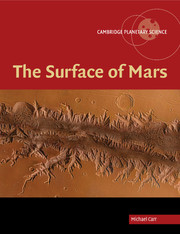13 - Implications for life
Published online by Cambridge University Press: 12 August 2009
Summary
From the beginnings of telescopic observations of Mars, people have speculated about whether life could have started on the planet and what that life might be like. While the concerns of early observers were mostly with intelligent beings with whom we might communicate, the focus now is on life's origins, microbial communities, and the limits to their survival. Views on the prospects for life on Mars have varied greatly in recent decades. During the 1960s it was thought plausible that vegetation could be present on the martian surface. Some observers noted a seasonal wave of darkening that moved from the poles to the equator in spring and attributed it to vegetation. The Mariner-Mars program originally planned to launch two spacecraft to the planet in 1971. One was to systematically map the planet, the other was to be put into a Mars-synchronous orbit to carefully monitor surface changes that might have a biological cause. One of the spacecraft was lost at launch and the two objectives were ultimately combined in Mariner 9. The search for life continued with the Viking landers. Each carried a sensitive instrument for detecting organic molecules and an elaborate array of biology experiments devoted to detecting metabolism. The negative results from both these experiments in the late 1970s, and a better understanding of the harsh conditions that prevail at the surface today, resulted in considerable pessimism about the prospects for life on Mars, which persisted through the 1980s.
- Type
- Chapter
- Information
- The Surface of Mars , pp. 267 - 276Publisher: Cambridge University PressPrint publication year: 2007



